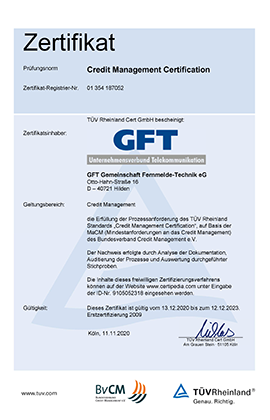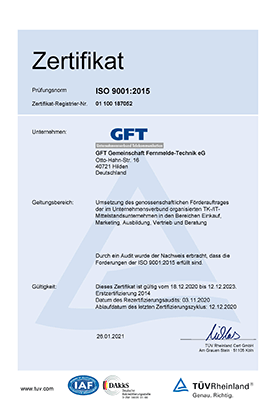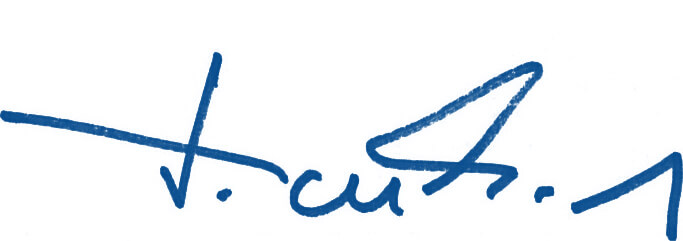FORECAST, RISK AND OPPORTUNItyreport
Forecast report
General economic conditions
The resurgence of Corona infections will once again weigh on the German economy in the winter half-year 2021/2022. Industry continues to suffer from production disruptions due to a lack of inputs. Corona illnesses among employees can now exacerbate this. In consumer-related services, pandemic-related customer restraint is again choking off the recovery.
Stable GDP growth forecast for 2022 in all GFT markets.
Nevertheless, companies are entering the new year with a high degree of confidence. This is an encouraging environment for the economy. Pent-up consumption and long overdue investments are waiting to be realised. This pent-up demand feeds optimism. Half of the business associations surveyed by the Institut der deutschen Wirtschaft at the end of 2021 expect higher investments in their sector in 2022. Particularly within the service sector, the investment outlook is brightening.
Source: Ifo-Institute; Bank Austria; Wifo Austria, Eurostat
IIn the current year, expenditure on information technology, telecommunications and consumer electronics will therefore grow by 3.6 percent compared to 2021 and is expected to reach a volume of 184.9 billion euros.
In information technology, sales of 108.6 billion euros are expected in 2022 - this is a growth of 5.9 percent compared to 2021. Expenditure on software will see the greatest growth in this segment with an expected 9.0 percent to 32.4 billion euros. IT services, with a volume of 43.0 billion euros, will still represent the largest share of the IT market in 2022 (+3.9 per cent), ahead of IT hardware. Expenditure on IT hardware will rise by 5.7 per cent to 33.2 billion euros in the current year.
Telecommunications is expected to continue the moderate growth of the previous year with a plus of 0.9 percent to 67.3 billion euros. Growth of 2.2 percent and 1.7 percent to 6.9 percent and 49.2 billion euros, respectively, is forecast for the submarkets of telecommunications terminal equipment and telecommunications services. Investments in TC terminals will decline by -3.1 percent to 11.2 billion euros in 2022.
forecast turnover in information technology in 2022.
Market volume telecommunications in Germany.
Market growth in telecommunications.
|
Forecast ITC & Security Technology |
2019 |
2020 |
2021 |
Forecast |
|
I. Total ITC + CE |
170,7 |
171,7 |
178,4 |
184,9 |
|
II. Telecommunications |
66,7 |
66,0 |
67,4 |
67,3 |
|
Telecom equipment |
11,3 |
11,6 |
11,6 |
11,2 |
|
Telecom infrastructure |
6,9 |
6,8 |
6,7 |
6,9 |
|
Telecommunications services |
48,5 |
47,6 |
48,4 |
49,2 |
|
III. Electronic security technology |
4,6 |
4,7 |
5,0 |
5,4 |
|
Burglar alarm technology |
0,9 |
0,9 |
0,9 |
1,0 |
|
Fire alarm technology |
2,2 |
2,2 |
2,4 |
2,5 |
|
Video security technology |
0,6 |
0,7 |
0,7 |
0,8 |
|
Access control systems |
0,4 |
0,4 |
0,4 |
0,4 |
|
Voice alarm systems |
0,1 |
0,1 |
0,1 |
0,1 |
|
Smoke alarm systems & others |
0,5 |
0,5 |
0,5 |
0,5 |
|
Total ITC + security technology |
71,3 |
70,7 |
72,4 |
72,7 |
|
Change vs. previous year |
0,1% |
−0,9% |
2,5% |
2,9% |
Market for safety technology continues to grow disproportionately to other sectors
The market for safety technology will maintain its disproportionate growth compared to other industries in the current year. Various market research institutes assume that the industry will grow globally by an average of 7.5 % per year until 2025. The service segment will develop slightly below average in the initial year with a forecast 5.5 % growth p.a..
As the markets and geopolitical developments of the last 15 to 20 years have shown, markets are becoming increasingly disruptive, crises are hitting at ever shorter intervals and economic policy frameworks are changing around the globe. This makes it clear that the resilience of companies in an industry cannot be measured only by the general growth trend. Security technology must adapt to the key trends that will influence the entire industry over the next five to seven years. Many of these trends are well known, but their overall impact must be viewed from a new angle.
As described elsewhere, "remote security" has become increasingly important not only since the Covid 19 pandemic. But the pandemic has definitely helped to further accelerate this trend. The Calipsa Annual Report of 2021 already shows that about 75 percent of the companies surveyed use cloud-based video analytics and about 32 percent rely on completely cloud-based systems. This trend is being fuelled above all by the security-as-a-service models that have been gaining ground for years in conjunction with software-as-a-service offerings.
"Remote Security" on the rise in the security technology sector.
The essential advantage of these concepts is the simple and problem-free scaling of the security solutions with the general business development of the customers, but above all the fact that the subscription or subscription models commonly used in this context ensure that not only the software but also the hardware are always state of the art. Another benefit of cloud technologies is that they are indispensable as the backbone of modern AI/AI solutions, because systems that use artificial intelligence are dependent on high-performance computing platforms if they want to be at the forefront of technology.
Artificial Intelligence (AI) remains a top trend
AI (Artificial Intelligence) and with it "Machine Learning" are still considered to be the greatest forces for change in security technology. To the extent that they can be used to overcome pure forensic analysis after a security incident, their potential and the benefits for all involved also increase. The capabilities and speed of AI/AI will continue to accelerate in the coming years. Even if this still requires the use of powerful systems, they are already delivering invaluable benefits in the context of so-called predictive analytics, as various systems in use for predictive policing, among other things, show.
"Artificial Intelligence" – another trend in the field of security technology.
The ultimate goal of all these systems is to prevent security incidents before they happen, which admittedly still sounds like a lot of pie in the sky. Above all, however, AI/AI should support operators in evaluating and handling mass data, for example via video analysis, false alarm filtering and improving operating efficiency. According to analyses, the market for AI/AI in the industry is estimated at around USD 5 billion in 2020, and the development until 2026 is estimated at around USD 14 billion worldwide.
Convergence of traditional security technology and cybersecurity
Due to the widespread use of IP technology in security technology, cybersecurity plays a key role: every device that is directly or indirectly connected to the internet is a potential target for cyberattacks. The attacks that have already taken place and the takeover of, for example, IP cameras and other IoT devices in security technology via so-called botnet attacks have impressively demonstrated the risks and dangers in recent years. If the trend towards cloud- and remote-based security systems described above gains in importance, a further convergence of classic security technology and cybersecurity is inevitable: The protection of physical and IT technology can no longer be separated.
Cyber security will play a leading role in the field of security technology in the future.
This leads to an interesting effect that partly runs counter to the trend towards cloud and remote applications: In another study, as many as 64 percent of the companies surveyed in 2021 stated that cyber security is the central obstacle to the introduction of cloud-based systems. On the other hand, the lack of understanding or expertise about cloud systems was named as the third obstacle - mind you: IP devices are also "somehow" on the web and can therefore be attacked. For this reason, comprehensive knowledge about the cyber risks as well as the appropriate defence mechanisms is indispensable for setting the right course in the realignment of security technology.
annual growth forecast in the safety technology sector until 2025.
Risk report
Description of the risk management system
GFT has a holistic IT-supported risk management system with the help of which risks are recorded, documented, aggregated and analysed. Risk inventories are carried out at regular intervals, whereby risks are identified, described and evaluated. In this way, the necessary measures to avert potential damage to GFT can be initiated at an early stage.
All risks are assigned to specific areas based on their origin in the so-called risk inventory. In this way, market and financial risks as well as political, legal, technical and organisational risks are differentiated. When identifying and evaluating risks, the focus is on the stable earnings and asset situation and the financial independence of GFT, which can be influenced by both internal and external factors.
The risk management system is supported by a quality management system (QMS) documented in writing in accordance with DIN EN ISO 9001:2015. GFT's risk management system has remained unchanged compared to the previous year.
GFT has a documented QM in accordance with DIN EN ISO 9001:2015.
Risks of future development
Once a year, a report is prepared on all risks and the corresponding countermeasures, which is presented to the committees in the event of significant risk deviations. In November 2021, GFT was recertified by TÜV Rheinland Cert GmbH, Cologne, following an audit with the confirmation that the established quality management system is being properly applied.
The basis for this, in addition to the requirements of the "Credit Management Certification" standard based on the Minimum Requirements for Credit Management (MaCM) of the Bundesverband Credit Management e. V., the GFT credit guideline with statements on customer master data, credit assessment and monitoring, credit limit and monitoring, collateral for receivables, payment transactions and conditions, dunning and delivery blocking as well as debt collection.
Independent of the risk management system, the promotion and demand of a high level of quality and risk awareness on the part of all GFT employees minimises the occurrence of internal risks. Binding process instructions and guidelines that exist in all relevant company divisions are helpful in this regard. In addition, there are insurance policies with standard market coverage and deductibles, including against natural hazards and liability damage. No property insurance policies are taken out for everyday operational risks in order to promote the cooperation of all process participants in loss prevention.
Binding process descriptions and guidelines ensure a high level of quality and risk awareness.
To minimise legal risks, external lawyers are involved in all major legal transactions. If necessary, additional lawyers specialised in the respective field of law are consulted. If contractual or litigation risks are identified, adequate provisions are made. GFT's performance is also maintained in the event of negative external influences, as these risks which cannot be directly influenced - for example, through negative legal or political developments in the market environment - are also constantly monitored. If necessary, corresponding scenarios and catalogues of measures are developed.
The del credere commitment for our members vis-à-vis our contract suppliers results in a significant risk of bad debt losses, which is reinsured by credit insurance. A comprehensive accounts receivable and accounts payable management system has been set up to minimise the risk. To reduce the risk of default, the creditworthiness of the business partners is checked and the open accounts receivable are closely and continuously monitored. In individual cases, additional collateral is agreed to limit the risk. Potential default risks are taken into account by setting up value adjustments.
Bad debt losses are reinsured through credit insurance to minimise risk.


Credit Management Certificates of GFT
Opportunities Report
General statement on the risk situation
Due to the stable growth of our members at home and abroad, we see ourselves well positioned for the future. In addition, our members are growing into new business fields related to advanced building technology alongside their traditional business fields. Here we see interesting starting points for GFT to successfully accompany our members on this growth path by taking on new suppliers in other business fields.
Significant risks continue to include gross profit risks such as a falling trade margin, deterioration in purchasing conditions and the latent risk of bad debt losses due to rising insolvency rates in the context of the COVID 19 pandemic. The turnover level of the previous year could not be maintained in the past year with a minus of 2.0 percent. The reason for this was a weak fourth quarter of 2021 due to supply bottlenecks after three strong quarters. However, we do not see this as problematic, as orders were ultimately postponed into the new year and there will be catch-up effects once the international procurement markets have regained full supply capability. Nevertheless, the strength of the GFT group of companies is characterised by a payout ratio almost at the previous year's level. In relative terms, the total payout ratio rose to 3.77 percent.
Stable total payout ratio in 2021 despite decline in revenue.
Against the backdrop of increasing membership numbers in Germany, expansion into Austria and the Netherlands, as well as the continuous increase in the procurement quota of our members through the inclusion of new suppliers, we assume that we will be able to successfully fulfil the cooperative's promotional mandate in 2022 as well.
Our goal is to generate an appropriate total distribution to members in the current business year, which should be at least at the level of the past business year. However, this presupposes that our member companies continue to succeed in concentrating their revenues on GFT and that the economic development continues to recover in the context of the pandemic.
Thanks for commitment and solidarity
After a challenging year, which was again marked by the pandemic, we would like to thank our members for their good cooperation and for their trust.
We would also like to extend this thanks to our staff. They, too, have shown unprecedented dedication. Many of them committed themselves for weeks or even months beyond their normal workload and worked overtime. We know that this cannot be taken for granted.
The Executive Board

Rudolf H. Saken
C E O

Dr. Stefan Touchard C F O
Hilden, March 2022

